Today, almost everyone is familiar with Microsoft Office. Entire generations of students have grown up with Word and PowerPoint. Cohorts of finance professionals are forced to master Excel. In short, Microsoft Office is thoroughly embedded in our digital lives.
Pre-1995, however, Office was nowhere near as dominant. Lotus 1-2-3 and WordPerfect — not Excel and Word — were the respective market leaders in the spreadsheet and word processing application categories. 1-2-3 was so successful, in fact, that it was seen as the PC’s first ‘killer app’, leading the charge for the PC revolution in the 1980s.
These two applications held on to the top spots from the mid-1980s to the early 1990s, when most computers did not have a graphical user interface (GUI). Instead, computers had command-line or text-based user interfaces. Practically, it meant computer users had to memorise keyboard commands to use the computer; there was no such thing as a mouse.
In 1984, the launch of the Apple Macintosh signalled that the times were a-changin’. The Mac came with a GUI where, amongst other features, users could magically drag and drop things with a mouse. As a New York Times journalist wrote:
The fundamental difference between the Mac and other personal computers is that the Macintosh is visually oriented rather than word oriented. You choose from a menu of commands by simply pressing the wandering mouse's button rather than by using a number of control keys or by entering words.
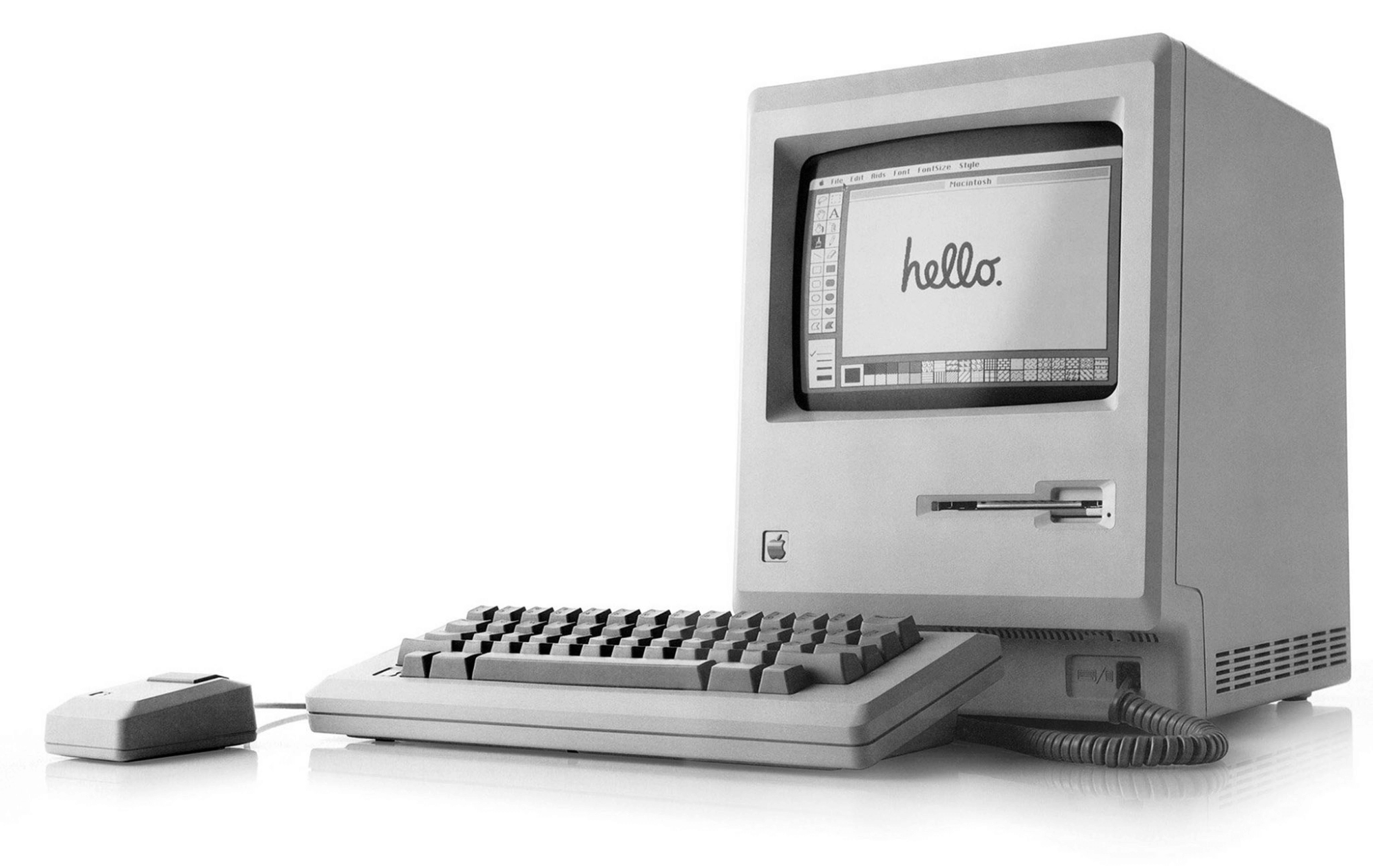
Image sourced from Tim Cook.
Microsoft quickly followed suit in 1985 with Windows 1.0. It also utilised a simple GUI which gave users drop-down menus, scroll bars, and icons — all of which made computing more user friendly.
Not everyone believed in the future of GUI computing though. The majority of computer users at the time were already used to typing commands and navigating with the keyboard only. To them, it was faster and more efficient than using a mouse on a GUI. One computer enthusiast wrote in a 1985 newspaper:
The mouse is yet another in the long line of computer devices that try to make our work easier and more efficient. I am not convinced that it will, except, of course, when I want to draw pictures. Then the mouse is the next best thing to a pen. If I could teach a mouse how to do data input, I’d make a million. But for now I guess it’s back to the drawing board.
In this world of non-GUI computing, the leading Lotus 1-2-3 and WordPerfect applications possessed an entrenched and growing base of customers. 1-2-3 was the application for business computing. Once MBA students learned how to master it, they would use slash commands to quickly slice and dice numbers. Although 1-2-3 required users to remember commands, it was still a user-friendly application. It had explanatory messages, jargon-free prompts, and fail-safe mechanisms in case of mistakes. It even received praise from the computer magazine Byte for its “human engineering” because it was one of the few pieces of software that could be used by anybody in 1982. As a sign of its dominance, many new PC ads started to highlight that their new machine could run ‘1-2-3’. Another PC magazine claimed in 1985 that ‘1-2-3’ must be one of the ‘best selling computer programs of all time’.

Image sourced from Anatoly Shashkin.
Likewise, WordPerfect had cultivated a loyal following of lawyers and law students. Undeterred by its manual of over 600 pages, these students learned how to write and format legal briefs using WordPerfect’s mysterious codes and commands. WordPerfect users had invested hours in learning the software, and many even paid extra to enrol in introductory courses. By 1992, WordPerfect had amassed a market share of over 60% for non-GUI operating systems.
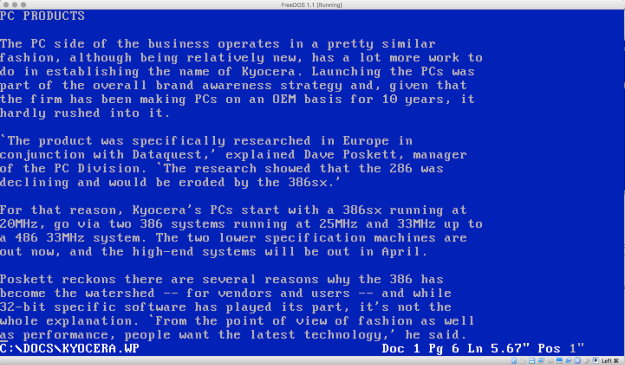
Image sourced from Machina Speculatrix.
Meanwhile, Microsoft held a secure, but lagging number two spot with its Excel and Word applications in Windows and MS-DOS (its non-GUI operating system). Ironically, the company held the number one spot with Excel and Word on the Macintosh. And their dominance on the platform was ridiculously strong: in 1989, Excel held a whopping 90% market share on the Mac.
During this time, the Office product teams were working hard to overtake WordPerfect and 1-2-3 on Windows. As an example, the 1993 release of Word 6.0 for Windows unveiled a group of ‘IntelliSense’ features. One of the features was AutoCorrect. As the first ‘do what I mean’ feature, it was revolutionary — automatically correcting small errors like ‘teh’ to ‘the’.
The feature originated from Word program manager Dean Hachamovitch. He was tasked to make Word more user-friendly and one of his insights was to modify an existing, but underutilised feature called ‘glossary’. The original feature allowed users to type a short phrase, hit the F3 key, and have Word replace the short phrase with longer text. Hachomovitch then realised that he could replace the awkward F3 key with the easier-to-type spacebar key and pre-populate the list of glossary entries with common misspellings. This modified version of ‘glossary’ evolved to become AutoCorrect.
Around the same time, the Excel product team was engaged in fierce competition with 1-2-3. They had adopted a team motto of “Recalc or die” — referencing the need to overhaul Excel’s calculation algorithm so that it could recalculate faster than 1-2-3. Eventually, Excel programmer Doug Klunder figured out how to achieve that by having Excel recalculate only the affected cells instead of the entire spreadsheet. The innovation would vastly improve the speed and performance of Excel, giving it an edge over 1-2-3.
These individual application improvements helped Microsoft gain market share against WordPerfect and 1-2-3, but a new competitive front was about to open. In 1989, Microsoft's marketing team experimented with packaging their already-popular Macintosh apps together as a software bundle. They put Word, Excel, PowerPoint and Mail together, named it Microsoft Office, and launched it with a retail price of US$895 (US$2,100 in 2022 dollars). This was a time when the standalone Microsoft Word for Windows in 1990 carried a list price of US$495 (US$1,100 in 2022 dollars). As they had hoped, customers responded favourably to the bundling, helping grow the Applications division of Microsoft.
Following the same successful marketing strategy, Microsoft Office for Windows was launched the following year with Word, Excel and PowerPoint. The bundle was shaping up to become a competitive category of its own. In response, Lotus entered the market with ‘SmartSuite 1.0’ in 1992 and ‘SmartSuite 2.1’ in 1993. Their bundle had five apps, 1-2-3 (spreadsheets), Ami Pro (word processor), Freelance (slides), Organizer (personal information manager), and Approach (database).
At the end of 1993, Microsoft’s Applications Division started developing and marketing the Office bundle instead of just the standalone apps. Although it was already their third year of selling Office for Windows, the Application Division’s internal structure had remained the same. While Office may have seemed like a unified bundle of products, in reality, each of the product teams (Word, Excel, PowerPoint) were still acting like independent tribes and operating under different release timelines.
The release of Office 4.0 laid bare this costly flaw. In October 1993, Office 4.0 was released with new versions of Word, Excel, PowerPoint, and Mail. But there was a major and embarrassing problem — the Excel and PowerPoint teams didn’t ship their products on time. This meant customers who purchased Office 4.0 in the first few months received “air boxes” which contained coupons to redeem the upcoming Excel 5.0 and PowerPoint 4.0. Those products finally shipped the following year, in April 1994.
Lotus took full advantage of Microsoft’s clumsiness. They advertised their full suite of apps, all ready to go, and mocked Office for selling IOUs. During this time, Lotus also fully committed to the Windows platform by rolling out a major update to 1-2-3.

Image sourced from Hardcore Software.
In early 1994, Microsoft Technical Assistant (and rising star) Steven Sinofsky explored Lotus SmartSuite 2.1 to see if it was legitimately an integrated and consistent bundle of apps. To his surprise, the applications were not consistent. For example, the icon placement varied across the different SmartSuite apps, from 1-2-3 to Ami Pro.
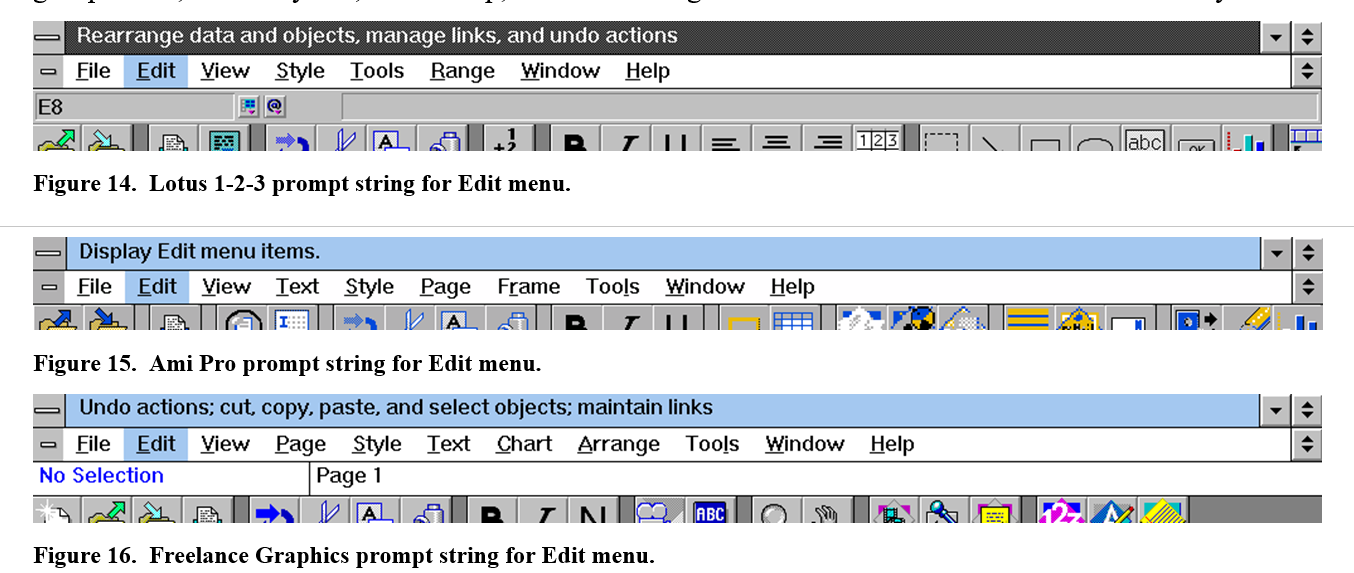
Image sourced from Hardcore Software.
Sinofsky went further and hunted down other inconsistencies and inefficiencies within SmartSuite. He copied-and-pasted across the different apps to see how each app would handle it. Would it allow copying from one app and pasting in another app? If so, would it paste with or without formatting? And would the content be affected?

Image sourced from Hardcore Software.
Using this information, Sinofsky drafted a nearly 30-page memo articulating the Office bundle as a strategy. It spread quickly within Microsoft, as it was the first clear articulation of a path to beating 1-2-3 and its ilk.
Sinofsky’s memo struck a chord with the Office team. In particular, it struck a chord with Pete Higgins, the Senior VP of the Desktop Applications Division (DAD). SmartSuite — despite its mediocre integration and lack of shared code — had impressed product reviewers, who were attracted to Lotus’s “working together” messaging. Sinofsky was irked by this marketing line; to some degree his memo was written to highlight the technical reality of SmartSuite, in contrast to Lotus’s marketing. Higgins believed that Office needed to follow suit, but they would need to deliver actual shared code, integration, and consistency. And perhaps this integration might finally give Microsoft the upper hand in the competition against Lotus and WordPerfect.
It’s worth mentioning that Sinofsky was just 27 years old at the time of the memo. He had some soft power as Technical Assistant to Microsoft CEO Bill Gates, but not a lot of real power — and he had to tread carefully if he wanted a future in Microsoft. Sinofsky sent out apologies every time someone asked for the memo; when Higgins commented “why didn’t our team write this up first?” (referring to the Office team, which Higgins was in charge of), Sinofsky was pleased but also worried. He had no intention of making the Apps team look bad.
Another reason the Sinofsky memo was taken seriously within Microsoft was that his argument for greater Office integration was aligned with Bill Gates’s technical obsession of the time. Gates had been beating the drum for more shared code internally for several months by this point; Sinofsky merely applied that perspective to the suite strategy. In addition, Gates had already stressed the importance of developing shared code and consistency in prior meetings with the Office team.
Despite the apparent popularity of Sinofsky's memo and the Office bundle’s preliminary success, the bundle strategy was still not a clear cut choice. Sinofksy wrote, years later, that the decision to bundle or not to bundle was a timeless question faced by many a product maker over the course of history. But this was the first time Microsoft had to answer the question, and they had to tackle the same few issues every bundler grapples with: would customers bite if one of the bundled products was not ‘best-in-class’? Would they come to value the consistency and integration of the bundle? Or would they resist the higher price point? Individual applications were cheaper than the full suite, after all.
The data was murky. At the time, most customers were not buying Word and Excel at the same time. Even fewer were purchasing PowerPoint. Realistically, would these customers want all the applications, or would they see it as a desperate marketing ploy? But on the other hand, it made sense that an Excel user would likely need to use Word … eventually. And it might have been the high cost of buying each application, separately, that deterred people from buying more than one. The list price of one application was around US$395 (US$780 in 2022 dollars). Sinofsky writes:
The notion that the software would become a significant portion of the price of the computer was perplexing at the retail counter, no matter how much Microsoft was spending on Research & Development or how much that metric might not make sense. The industry was not quite ready for software to become a bigger business than hardware—it was the computer business.
Eventually though, Microsoft decided to make the strategic pivot towards Office. They reorganised, created a new business unit under DAD called Office Product Unit (OPU) and offered Sinofsky the role of group program manager. DAD would now house the business units of Word, Excel, PowerPoint, and the newly created OPU. The reasoning was that if Microsoft were to market and sell Office externally, its internal structure would need to reflect that too. One of OPU’s tasks would be to ensure that all of Office shipped at the same time. The embarrassing and costly “air box” from Office 4.0 could not happen again.
Employees did not like this reorganisation. The Word, Excel, and PowerPoint teams felt like they were being told to do more with less. They now had to ship on time and on the same timeline, but with less people — as some team members were transferred ‘upstairs’ to the OPU. For the Word and Excel team members, their default answer to everything became “go ask OPU as they have all the resources.”
Sinofsky, as group program manager of OPU, saw the other side of the issue. They had to balance between drafting the best people from the individual app teams or accepting volunteers. If they filled their team by drafting the best, it would be an effective unit, but morale would be damaged. Those drafted might not genuinely believe in the mission of OPU and those not drafted may start to see themselves as second-class employees. Alternatively, if OPU was filled with all volunteers, it would be a team of ‘missionaries’, but it also would give off the impression that OPU wasn't truly a high priority.
After OPU was formed, the team set off by developing constraints instead of trying to negotiate start and finish dates for the different app teams. They chose the biggest constraint — ship Office as a completed product and time it so that it would launch within 30 days of Windows 95.
On top of this, DAD’s leadership had also decided that they would work on two releases of Office. The first would be in sync with Windows 95’s launch and the second would be in sync with the successor of Windows 95. This plan became known as ‘12/24’: they would ship one release, Office 94 (which became Office 95), in 12 months and the second release, Office 96 (which became Office 97), in 24 months. When the app teams learned of this, it seemed like they had signed up for not just one, but two impossible tasks. The developers believed that “nothing” could be done in 12 months. There was no time to write code and develop new features. And they somehow still had to ship the new versions of Word, Excel, and PowerPoint as one finished product for Office!
In light of this insanely tight schedule, the DAD decided to hedge their bets by allocating only 15% of their teams to Office 95 while everyone else worked on Office 97. They saw Office 95 as an excellent opportunity to prove Office as a product and OPU as a team. If Office 95 shipped successfully, it would be the first time Office launched as one complete product.
To help convince the remaining sceptics, the GM of Word, Peter Pathe, would remind his team that “the best feature we have for competing with WordPerfect is Excel”. To be fair, Word had already made great strides against WordPerfect at this point in time. By 1994, it had won 90% of the word processing market, thanks to Pathe’s leadership and the Word team’s history of consistent execution. But Pathe’s messaging still crystallised — the success of one app depended on the success of the bundle.
As an example of the push, Autocorrect (first deployed in Word 6.0 from Office 4.0) was extended to Excel and PowerPoint for Office 95. The Excel team initially resisted the implementation because they worried that it would introduce errors and insert the wrong formulas. They would bring up their belief that “Excel users are different”. But OPU would ask in return: “Why, because they don’t make typos?” In the end, OPU pushed through and ensured that Office 95 would not only share the AutoCorrect feature, but also a common list of entries across the products — a typo found in any of the apps would be corrected the same way. It marked a small, but decisive step towards a true bundle of apps.
OPU continued to standardise the apps for Office 95. They standardised the commands available in the toolbar, the ability to include content from Word or Excel in PowerPoint, and then they standardised even the pixel size of the toolbar (a debate between 15 or 16 pixels)!

Image sourced from Hardcore Software.
During Office 95’s development, the Word team had the breakthrough idea of background spell check. Spell check was an existing Word feature, but it required users to stop what they were doing to activate it. When activated, spell check would then highlight every misspelt word from the start of the document and make the user correct, ignore, or add the supposed typo into the dictionary. It interrupted the user’s workflow and took up a lot of time, especially for long documents.
Jim Walsh, Word’s then-development lead, learned of this problem when he noticed that many of the documents he received from corporate customers had spelling mistakes. There were enough mistakes to make him ask if they had used spell check. The customers said yes, but they probably forgot to do so for the final few versions of the document. They either assumed that someone else had already activated spell check, or they simply didn’t have the patience — at the end of the work day — to stay back a little longer and run spell check on their long documents.
Around the same time, Walsh was doing performance-related and bugfix work with the ‘idle loop’ — the term for when Word did nothing while the user took a break from typing. He found that Word was already using the idle loop to walk through the document in order to perform other tasks. Walsh found that there was still some processing headroom left in the loop, which he could use to run spell check. And thus, background spell check was born. Whenever the user stopped typing, it would kick in automatically and scan the document for spelling errors. If it found one, Word would render red squiggly lines beneath the error.
Background spell check soon became one of the biggest advances in IntelliSense. But it wasn’t without its critics. When released in Office 95, irritated customers mailed letters to Gates and Sinofsky. They were angry that their family names were flagged as misspellings. One of those letters came from the Phenis family, for instance, who did not like to see their name underlined and especially did not appreciate the suggested spelling.
To be fair, these letters only represented a minority of Word’s customers and the issues raised were patched in subsequent product updates. For the majority of customers, background spell check was a showcase feature for Word and Office. Today, the feature can be found in pretty much every word processor (and perhaps even web browser!) on the planet.
***
In early 1995, the Windows 95 team chose early summer as their ‘release-to-manufacturing’ date. Office 95 was ready to launch simultaneously. Now, it was time for the development and marketing teams to work together. They had to align the product SKUs, names, and brands between the software and physical product design. Oddly enough, even Office 95 had to undergo testing by an independent agency to receive the ‘Designed for Windows 95’ badge. It was such a frustrating process that the Office team felt like there was a conspiracy against them — that the independent agency held them to a higher standard than other third party apps. Only after a few tests, which cost about $1,000 each, did Office finally get certified (see the ‘Designed for Windows 95’ badge at the top left of the image below). It had come just in time for them to ship the physical boxes of Office to the thousands of distribution centres and retailers worldwide.
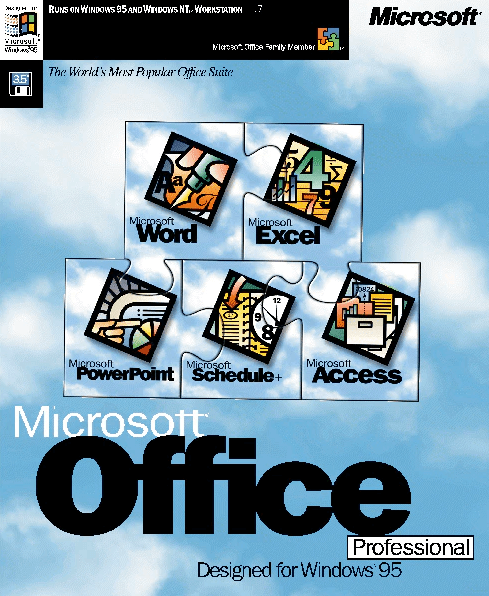
Image sourced from Hardcore Software.
On August 24, 1995, Microsoft released Windows 95 and Office 95 with a launch event hosted by Jay Leno. Microsoft had doled out more than US$200 million (US$383 million in 2022 dollars) on marketing. On launch day, the hype was everywhere. New York’s Empire State Building lit up in red, yellow, and green — the colours of Microsoft’s logo (due to technical problems, blue wasn’t included). Toronto’s CN tower featured a 300-foot Windows 95 banner. Londoners were treated to a free copy of The Times newspaper which had front page ads of Windows 95, courtesy of Microsoft. The company had taken over computer retailers, radio stations, and television channels with their iconic “Start Me Up” advertisements. Some retail outlets would see crowds of excited customers rush into their stores at the stroke of midnight just to purchase their copy of Windows 95.
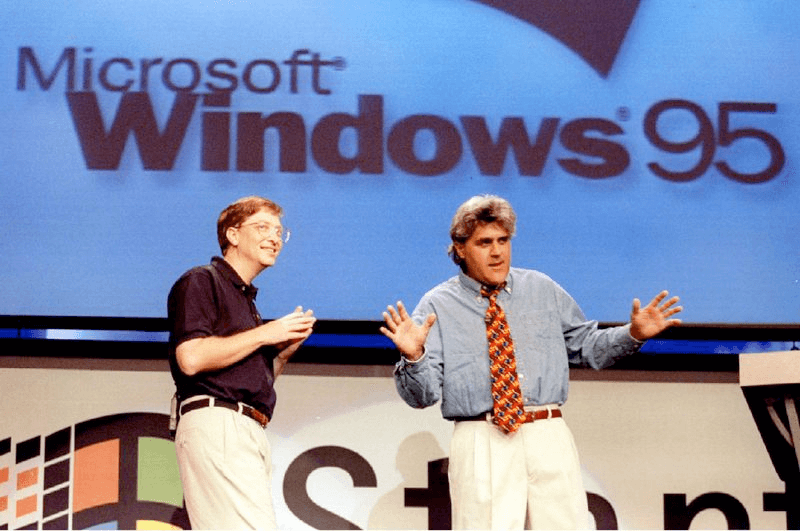
Image sourced from The Verge.

Image sourced from Yahoo News.
Beside every warehouse pallet and store display of Windows 95 was a pallet and display of Office 95. The DAD had achieved the impossible — shipping Word, Excel, and PowerPoint on time and selling Office 95 as a single, complete product for the first time ever. It boasted AutoCorrect, background spell check, a standardised user interface, and inter-Office compatibility.
While Microsoft’s leadership had developed conviction around the bundle strategy, it was ultimately mistakes by Office’s competitors that sealed their fate. Lotus had delayed building apps for Windows 95 — they were bought by IBM a few weeks before Windows 95’s launch; IBM had a competing operating system called OS/2 — which meant that Lotus was temporarily out for the count. As Lotus was the only other competitor with a real suite, this was a pretty significant event for Office. WordPerfect had teamed up with Borland (known for its Quattro Pro spreadsheet app) in 1993 to build a bundle for Windows, but two different companies building an integrated bundle proved to be challenging.
After launch, Windows 95 sold seven million copies in five weeks to become the world’s most popular operating system. PCs were no longer restricted to businesses, computer hobbyists or tech geeks. And Office 95 would be the bundle riding on this wave of success, marking the beginning of the end of Lotus, WordPerfect, Borland, and more.
***
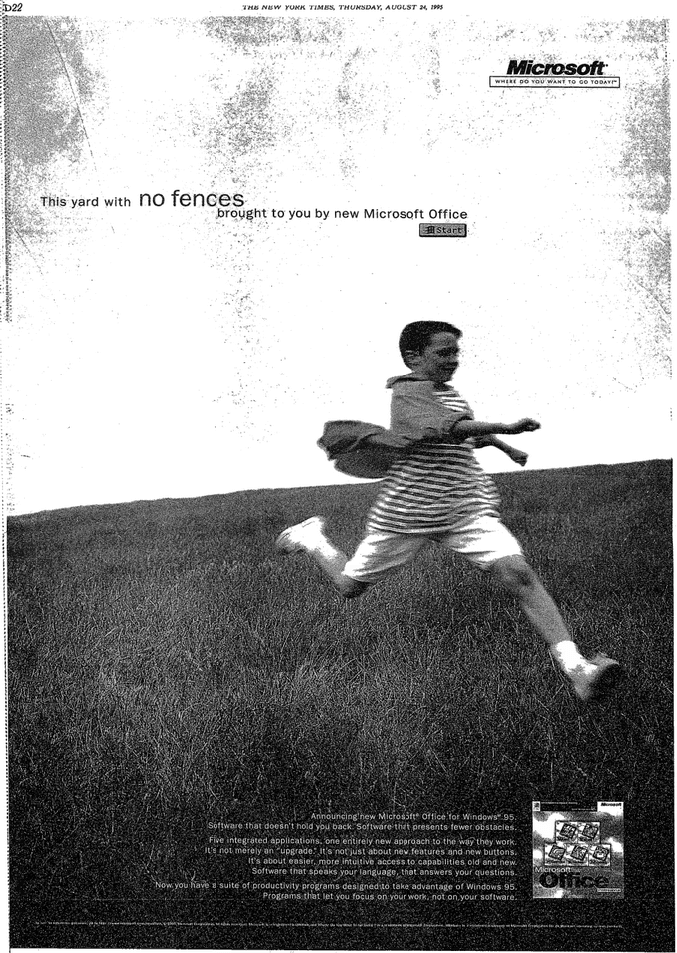
Image sourced from page 90 of The New York Times issue for August 24, 1995.
A full-page Microsoft Office 95 ad that ran in The New York Times.
The top copy reads:
This yard with no fences brought to you by new Microsoft Office.
The bottom copy reads:
Announcing new Microsoft Office for Windows 95. Software that doesn’t hold you back. Software that presents fewer obstacles.
Five integrated applications, one entirely new approach to the way they work. It’s not merely an “upgrade”. It’s not just about new features and new buttons. It’s about easier, more intuitive access to capabilities old and new. Software that speaks your language, that answers your questions.
Now you have a suite of productivity programs designed to take advantage of Windows 95. Programs that let you focus on your work, not on your software.
Questions
Compare this case with a previous case you've read. What is similar? What is different?
Does this remind you of a similar case? If so, what is different there?
If you have any thoughts, feel free to comment in the member's forum.
Sources
Hardcore Software by Steven Sinofsky.
Microsoft Office: Finding the Suite Spot by Harvard Business School.
https://www.theregister.com/2013/01/26/mitch_kapor_lotus_123_anniversary/
https://aresluna.org/attached/computerhistory/articles/spreadsheets/lotus123review
https://www.atarimagazines.com/compute/issue59/review_lotus_123.php
https://www.nytimes.com/1992/03/30/business/wordperfect-executive-is-forced-out.html
http://jvlone.com/computerpub/InfoWorld/IW_1990-01-15_x-x_MicrosoftWordWindows10.pdf
https://www.nytimes.com/1995/08/24/business/midnight-sales-frenzy-ushers-in-windows-95.html
https://www.washingtonpost.com/wp-srv/business/longterm/microsoft/stories/1995/debut082495.htm
https://news.microsoft.com/announcement/launch-of-windows-95/
